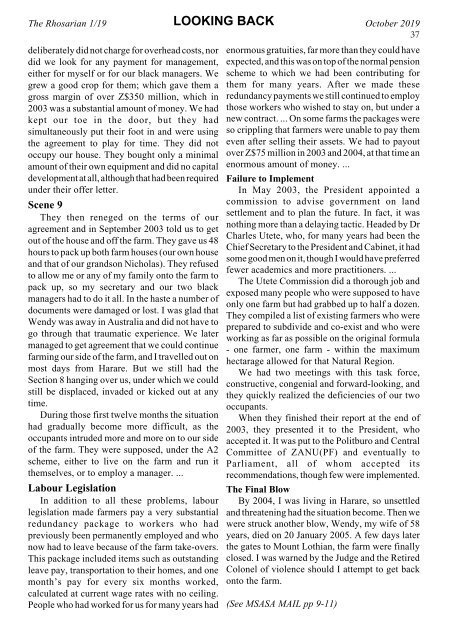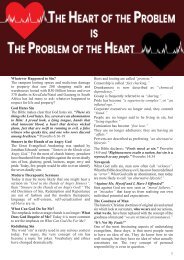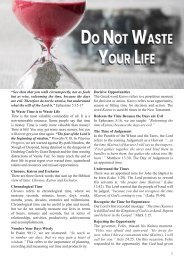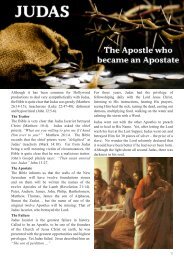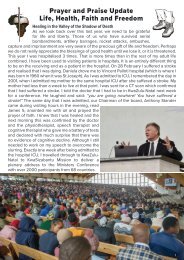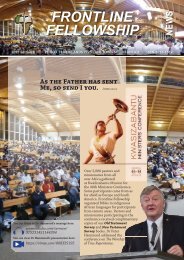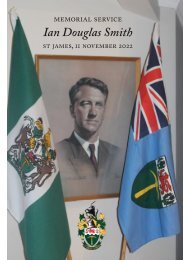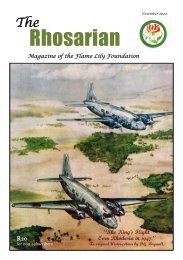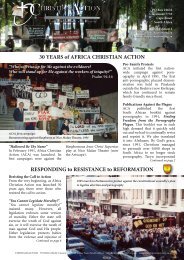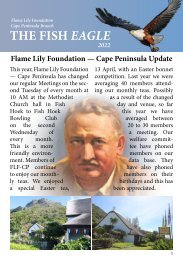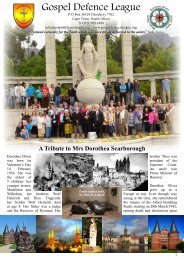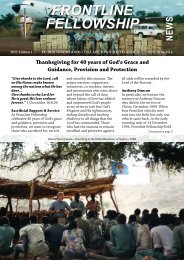Rhosarian 2019
You also want an ePaper? Increase the reach of your titles
YUMPU automatically turns print PDFs into web optimized ePapers that Google loves.
The <strong>Rhosarian</strong> 1/19<br />
36<br />
Scene 8<br />
As we had been ordered to cease production,<br />
all work in the greenhouses came to an abrupt<br />
halt. We were not allowed to continue during that<br />
fortnight to irrigate, fertilize or harvest the crops<br />
in the greenhouses, so it was pointless to throw<br />
good money after bad. We were then, after all,<br />
allowed to stay on, but with two ‘settlers’.<br />
Mount Lothian is a small farm of just over 550<br />
hectares, of which only 250 hectares are arable.<br />
Its size complied with the maximum farm size for<br />
this area, as laid down by government. But it<br />
seemed that government policy was to make<br />
farmers downsize their farms and co-exist with<br />
either Al peasant farmers or A2 large-scale settlers<br />
who wished to farm commercially, with the<br />
previous owner farming the rest of the land.<br />
Government policy sub-divided the settlers<br />
into two categories, Al and A2. The former were<br />
allocated 10 to 30 hectares, depending on the<br />
Natural Region, in many cases hardly enough for<br />
their own requirements. They were grouped<br />
together to facilitate the distribution of fertilizer<br />
and seed. But there was no provision for<br />
infrastructure such as wells, boreholes and<br />
buildings. These Al settlers were just dumped on<br />
the land and largely left to fend for themselves.<br />
The A2 settler group consisted of people who<br />
were allocated substantial areas, sometimes part<br />
of a white-owned commercial farm, or more often<br />
the whole farm. They were given 200 to 400<br />
hectares, depending on soil and rainfall and<br />
therefore the Natural Region division, and in<br />
theory had adequate financial resources of their<br />
own to supplement government loans. There was,<br />
however, no acreage limitation for the elite, and<br />
many simply seized a number of farms.<br />
It was in the A2 category that every High Court<br />
judge, except two, and four of the seven judges of<br />
the Supreme Court took one farm or more, as did<br />
almost every Cabinet minister and senior official<br />
in the public service. Importantly, they were<br />
supposed, immediately on occupation, to start to<br />
build their own house, workshop and other farm<br />
buildings and facilities, and, if they were not<br />
going to live on the farm themselves, to employ a<br />
manager. But many simply used the farm as a<br />
weekend retreat. Of course, production fell<br />
LOOKING BACK<br />
October <strong>2019</strong><br />
dramatically. In most cases not only was the<br />
original farmer evicted but all his workers and<br />
their families were as well.<br />
Many of the best farms in Enterprise, one of<br />
the best farming areas in the country, had been set<br />
aside for the elite. The two ‘settlers’ allocated our<br />
farm were the then Judge President of the High<br />
Court, Mr Justice Paddington Garwe, and a retired<br />
army colonel, Godfrey Matemachani.<br />
Although under ministry of Agriculture<br />
regulations, the farm had been classified as too<br />
small for subdivision, we undertook to downsize<br />
it to half its previous area, so that we farmed half,<br />
while Garwe and Matemachani farmed the other<br />
half. The Provincial Office approved the<br />
downsizing and the subdivision of the farm. We<br />
agreed to co-exist and to help and teach the new<br />
farmers the basics of farming. But they had no<br />
experience, no equipment and minimal capital.<br />
...<br />
We believed that if we did not downsize and<br />
co-exist we would probably lose the whole farm.<br />
It was obvious that both the settlers needed us in<br />
order to farm at all. They were quite frank about<br />
this, and admitted they had no farming experience.<br />
The judge did not have much money to invest and<br />
the retired colonel worked for the Commercial<br />
Bank of Zimbabwe in a management position.<br />
We therefore negotiated that the farm would<br />
be subdivided on a 50-50 basis and we would do<br />
everything for them to start them off. The<br />
agreement we produced, with top legal advice on<br />
our side, took months to conclude but was<br />
eventually signed by all parties in February 2003.<br />
This formal legal agreement laid down that we<br />
would manage the settlers’ section for the first<br />
year, they would pay only for direct costs and<br />
there would be no charge for my time or for<br />
overhead costs. At the same time we would try to<br />
teach them the fundamental aspects of practical<br />
agriculture. What we did was a gesture of goodwill<br />
and we hoped to provide a demonstration of what<br />
could be done. How wrong we were!<br />
Insidious Takeover<br />
We tilled the land, we planted the land, we<br />
grew the crop, we harvested the crop, we helped<br />
them source fertilizer and chemicals for the crop.<br />
We sold the crop and they got the cheque. We


